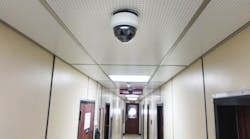Tailored risk assessments could help K-12 school districts secure security funding
Students from Milwaukee Public Schools may be returning from their holiday breaks to campuses staffed by law enforcement this coming year.
The district severed its last contract with the Milwaukee Police Department in 2020, following a several-year endeavor to remove officers from school campuses in 2016. A shared revenue bill passed by Wisconsin lawmakers last year reverses these efforts, with MPS administration now facing a required quota of at least 25 school resource officers posted across the district.
The mandate also makes the district responsible for funding the effort, which the state estimates at around $1 million annually in additional spending.
"The community likes the idea of having people who are there in the schools to maintain order and to make sure that kids are safe," said General Assembly Speaker Robin Vos (R) at a recent Milwaukee Press Club event.
On the heels of this decision, Milwaukee’s school districts need to be as precise as they can with their funding decisions to maximize their security. Anthony Seiler, Director of Vertical Strategy, Global Education and Data Centers at Johnson Controls (JCI), is encouraging school districts to use specialized risk assessments to pinpoint critical vulnerabilities without breaking the bank.
“You need to understand where the threat vulnerabilities are,” comments Seiler. “See that, and create a roadmap based on what you want to tackle first. Start at step one, and then move on to steps one through ten.”
Following the Roadmap
Seiler emphasizes the importance of developing a unique school-by-school risk assessment. No district is alike – urban and rural schools may have different needs and requirements that a one-size-fits-all security approach would have no way of covering.
JCI’s digital risk assessment solution was conceptualized following mass casualty events and other school security breaches nationwide. Administrators can use the tool to fill out a digital risk assessment and receive a unique generated roadmap listing the most critical and cost-effective actions available to shore up pressing vulnerabilities.
“We can create a comprehensive plan and roadmap, and then we can connect the dots between the two,” Seiler says.
Understanding a district’s unique security needs allows administrators to tackle their most relevant issues. Should a campus face more internal student behavioral risk than external risk, for example, natural access control systems tailored toward the campus environment may deter student behaviors like vaping and loitering in a more cost-effective way that offers more coverage.
“There are national tragedies facing all schools, but there are a growing number of security threats outside of mass casualties,” Seiler says. “You need to know what your plan looks like from a practicality standpoint and what security issues you might have over time.”
A District’s First Steps
Seiler advocates for a “crawl before you walk” approach: before a school reviews trending technologies like artificial intelligence or advanced gunshot detection, it must have a simple interior and exterior access control system in place first.
New and advanced technology may be exciting and safe to implement, he says, but means little if hostile actors can simply walk through the front doors.
Making certain there is a free flow of communication, from administrators to staff to first responders, is another vital factor when assessing risk, Seiler says. Ensuring lines of communication are integrated into a campus’ unique security system is perhaps the most important part of this step.
“Someone hopping a fence might be detected two to three minutes later, so information needs to be cascaded toward the correct individuals at the correct time,” Seiler says.
Properly communicating a school’s security systems to staff members is another key factor, Seiler notes: even the most sophisticated access control system can be thwarted by a teacher deciding to prop a door open at the wrong time.
Cybersecurity systems are also a notorious pain point for school districts due to funding or lack of collaboration with IT teams. “Sixty-four percent of building security decision makers feel they need to collaborate more with IT,” he adds.
This can be supplemented by employees who are trained to understand protocols and fostering collaboration between teams to prevent threats from slipping through the cracks. “K-12 school districts are one of the lowest-hanging fruits for cyber-attacks because they contain critical information in student records,” notes Seiler. “Only a third of school districts are properly staffed to handle them.”
An educational fiscal cliff
Targeting pain points by conducting a risk assessment also helps administrations combat one of the largest roadblocks they face: funding.
The Elementary & Secondary School Emergency Relief (ESSER) Fund, introduced to directly fund state education and local education agencies during the COVID-19 pandemic, provided over $100 billion dollars in funding for projects. The funding is expected to dry up this year, however, and school districts need to understand the budget constraints they are about to face.
“As ESSER begins to wane, state funding is going to ramp up, with a fiscal cliff approaching,” Seiler predicts. “Districts need to know exactly how much money is available to them and how to allocate it. This requires a clear vision of your security plan. With a roadmap in place, you can chase the available funding you need.”
Seiler plans to create an eligible-use guide through JCI’s digital risk assessment tool for districts and administrators to identify their funding needs for use on ESSER applications.
“We are working now to understand all of the state funding opportunities that apply to school districts so that we can offer very easy steps for them to utilize their funds to achieve what they need to,” he says.
A district that understands its security roadmap is less likely to feel financially restricted, he explains. Targeting and mitigating specific vulnerabilities online or on the perimeter is more cost-effective than taking a “spray and pray” approach to multiple threat vectors at once.
“Educators are in this profession because they care about kids. They don’t usually read legislation or look at funding mechanisms,” Seiler says. “We want to bring these solutions to educators and administrators in a way that is palatable and easy to understand.”
Samantha Schober is Associate Editor of SecurityInfoWatch.com.





